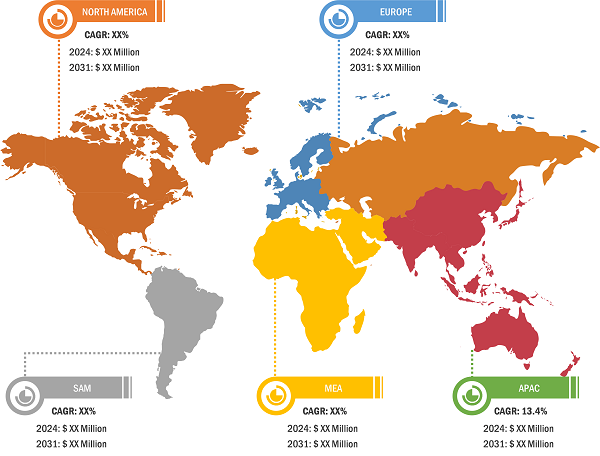Integration with IoT and Digital Twins Boosts Computer Aided Engineering Market Growth
According to our latest study titled "Computer Aided Engineering Market Forecast to 2031 – Global and Regional Share, Trend, and Growth Opportunity Analysis – by Product Type, Category Type, Distribution Channel, and Geography," the market was valued at US$ 11.03 billion in 2024 and is projected to reach US$ 23.44 billion by 2031; it is estimated to register a CAGR of 11.9% from 2025 to 2031. The report includes growth prospects in light of current Computer Aided Engineering market trends and factors influencing the market growth.
As IoT devices proliferate across industrial environments, they generate vast streams of real-time operational data from sensors embedded in machinery, vehicles, and infrastructure. This continuous influx of data enables computer-aided engineering models to be dynamically updated and refined, allowing simulations to accurately reflect the current state of physical assets. By feeding real-time sensor data into simulation environments, IoT integration empowers predictive maintenance strategies, wherein potential failures can be identified and mitigated before they occur, reducing downtime and maintenance costs. Real-time data integration enhances performance optimization, enabling engineers to fine-tune designs and operational parameters based on usage patterns and environmental conditions.
Computer Aided Engineering Market – by Region, 2024 and 2031
Computer Aided Engineering Market Size and Forecast (2021 - 2031), Global and Regional Share, Trend, and Growth Opportunity Analysis Report Coverage: By Component (Software and Services), Software Type (Finite Element Analysis, Computational Fluid Dynamics, Multibody Dynamics, and Optimization and Simulation), Deployment Model (On-Premise and Cloud-based), End-Use Industry (Automotive, Defense and Aerospace, Electronics, Medical Devices, Industrial Equipment, and Others), and Geography
Computer Aided Engineering Market Forecast 2025-2031 | CAE Trends
Download Free Sample
Source: The Insight Partners Analysis
Digital twins, powered by computer-aided engineering simulations enriched with IoT data, provide insights into the operational characteristics of complex systems. They enable engineers to conduct “what-if” scenarios, test modifications virtually, and predict outcomes under varying conditions without interrupting physical operations. This virtual experimentation accelerates product development cycles and improves reliability by identifying design weaknesses and performance bottlenecks early in the process. Further, digital twins support lifecycle management by continuously updating and adapting models based on incoming data, facilitating ongoing optimization and informed decision-making.
Integrating IoT and digital twin technologies with computer-aided engineering platforms marks an evolution toward more intelligent, connected, and adaptive engineering solutions. This trend accelerates computer-aided engineering adoption by demonstrating clear value in operational efficiency and product innovation, as well as paves the way for a future where simulation-driven digital ecosystems become integral to the entire engineering and manufacturing value chain. All these factors are anticipated to act as key trends of the computer aided engineering market growth.
The computer aided engineering market analysis has been carried out by considering the following segments: component, deployment, type, and end-use industry.
Based on deployment, the market is bifurcated into on-premises and cloud-based. The cloud-based segment held a larger computer aided engineering market share in 2024. By type, the market is segmented into finite element analysis, computational fluid dynamics, multibody dynamics, and optimization & simulation. Based on end-use industry, the market is categorized into automotive, defense and aerospace, electronics, medical devices, industrial equipment, and others. The automotive segment held the largest computer aided engineering market share in 2024.
The geographical scope of the computer aided engineering market report primarily entails North America (US, Canada, and Mexico), Europe (Spain, UK, Germany, France, Italy, and Rest of Europe), Asia Pacific (South Korea, China, India, Japan, Australia, and Rest of Asia Pacific), the Middle East & Africa (South Africa, Saudi Arabia, UAE, and Rest of Middle East & Africa), and South & Central America (Chile and Rest of South & Central America). North America accounted for the largest computer aided engineering market share in 2024.
The computer aided engineering market in North America is one of the most technologically advanced regions. It is led by the US and Canada owing to the strong presence of aerospace, automotive, defense, and high-tech electronics industries. Boeing, Lockheed Martin, Tesla, and General Motors use computer-aided engineering tools to optimize product design, reduce prototyping costs, and improve performance. The region’s high R&D spending, supported by public and private investments, boosts computer aided engineering market growth in this region. Technological advancements such as cloud computing, digital twins, and artificial intelligence (AI) are increasingly integrated with traditional computer-aided engineering tools, driving innovation and automation. The demand for accurate simulation and predictive engineering tools grows, especially in electrification and autonomous vehicle development. Additionally, North American universities and research institutions are crucial in computer-aided engineering tool innovation and skill development, contributing to a well-established ecosystem.
Europe represents a highly developed market for computer aided engineering, with deep-rooted industrial and engineering traditions, especially in countries such as Germany, France, the UK, and Italy. The region is a global hub for automotive innovation, with manufacturers and suppliers investing in simulation technologies to improve fuel efficiency, vehicle safety, and electric vehicle design. European industries are subject to stringent regulatory requirements, especially in the automotive, aerospace, and energy sectors, necessitating accurate simulation tools for compliance and safety assurance. Also, sectors such as renewable energy, marine, and rail are increasing their use of computer-aided engineering to optimize designs and reduce carbon footprints. The trend toward sustainability and green engineering in Europe boosts the demand for computer-aided engineering solutions, particularly those that aid in thermal and structural optimization. Further, Europe's support for Industry 4.0 and digital transformation encourages computer-aided engineering integration into enterprise systems such as PLM (Product Lifecycle Management) and ERP (Enterprise Resource Planning).
Autodesk Inc, Hexagon AB, Ansys Inc, Altair Engineering, Inc., Dassault Systemes SE, Bentley Systems Inc, PTC Inc, Siemens AG, Satven, and Technosoft Engineering Projects Ltd. are among the key players profiled in the Computer Aided Engineering market report.
Contact Us
Phone: +1-646-491-9876
Email Id: sales@theinsightpartners.com